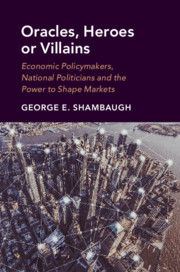 Oracles, Heroes or Villains
Oracles, Heroes or Villains Book contents
- Oracles, Heroes or Villains
- Oracles, Heroes or Villains
- Copyright page
- Dedication
- Contents
- Figures
- Preface
- Acknowledgments
- Abbreviations
- 1 Reaching for the Bazooka
- 2 Preferences, Power and Predictions
- 3 The Argentine Tango
- 4 The Federal Reserve Goes Political
- 5 A Greek Tragedy
- 6 Managing Markets in Turbulent Times
- Bibliography
- Index
1 - Reaching for the Bazooka
Published online by Cambridge University Press: 09 September 2019
- Oracles, Heroes or Villains
- Oracles, Heroes or Villains
- Copyright page
- Dedication
- Contents
- Figures
- Preface
- Acknowledgments
- Abbreviations
- 1 Reaching for the Bazooka
- 2 Preferences, Power and Predictions
- 3 The Argentine Tango
- 4 The Federal Reserve Goes Political
- 5 A Greek Tragedy
- 6 Managing Markets in Turbulent Times
- Bibliography
- Index
Summary
Speaking before the Senate Banking Committee on July 15, 2008, US Treasury Secretary Henry Paulson petitioned Congress for the authority to use taxpayer funds to prevent America’s mortgage giants Fannie Mae and Freddie Mac from collapsing. The hearing addressed widespread homeowner mortgage defaults that had sent stock prices plummeting and investors fleeing. Paulson argued that if investors came to understand that the government would not allow Fannie and Freddie to go under, stock prices would stabilize and a larger crisis could be averted. In a statement that would be repeated in news stories for years to come, Paulson speculated, “If you have a bazooka in your pocket and people know it, you probably won’t have to use it.” In this instance, the “bazooka theory” failed: Paulson not only had to fire his bazooka shortly after acquiring it, but its blast proved grossly inadequate to calm market uncertainty and forestall what became the worst financial crisis to hit the United States since the Great Depression. In spite of Paulson’s newly acquired money and authority, investors dumped Fannie and Freddie shares, both organizations fell into government conservatorship, political criticisms of bailouts grew louder and the whirlpool of uncertainty swirled ever faster.
Keywords
- Type
- Chapter
- Information
- Oracles, Heroes or VillainsEconomic Policymakers, National Politicians and the Power to Shape Markets, pp. 1 - 16Publisher: Cambridge University PressPrint publication year: 2019


